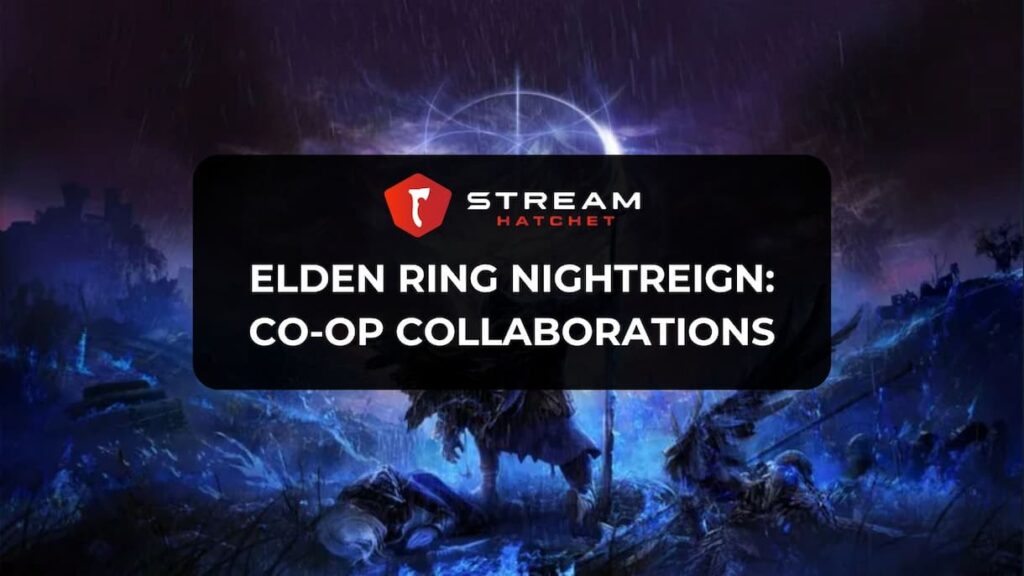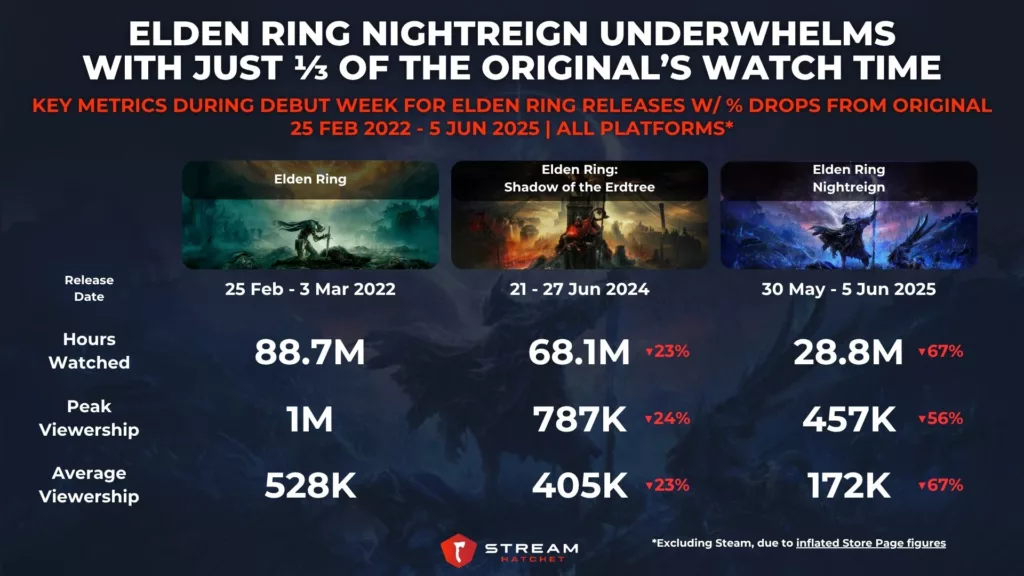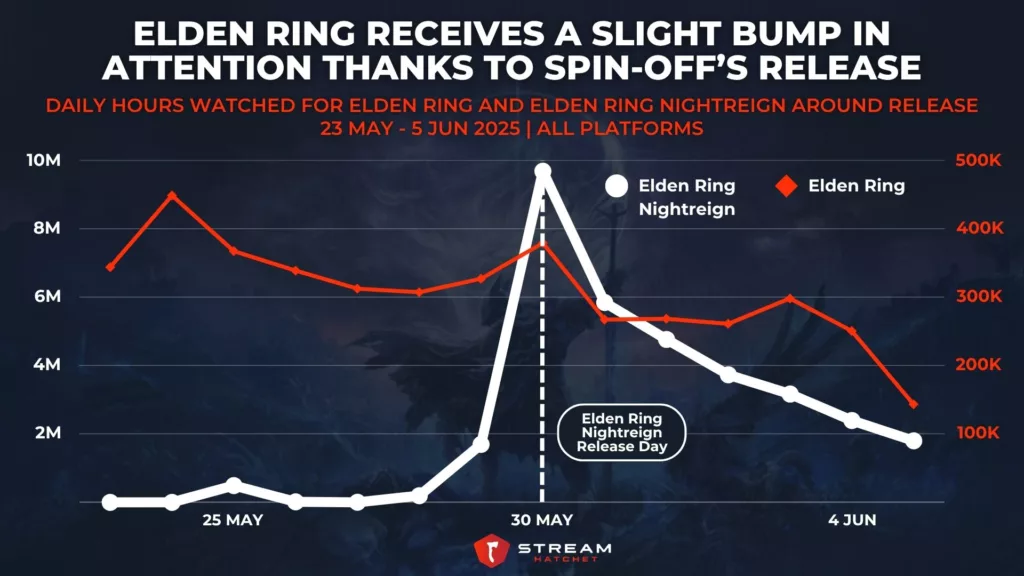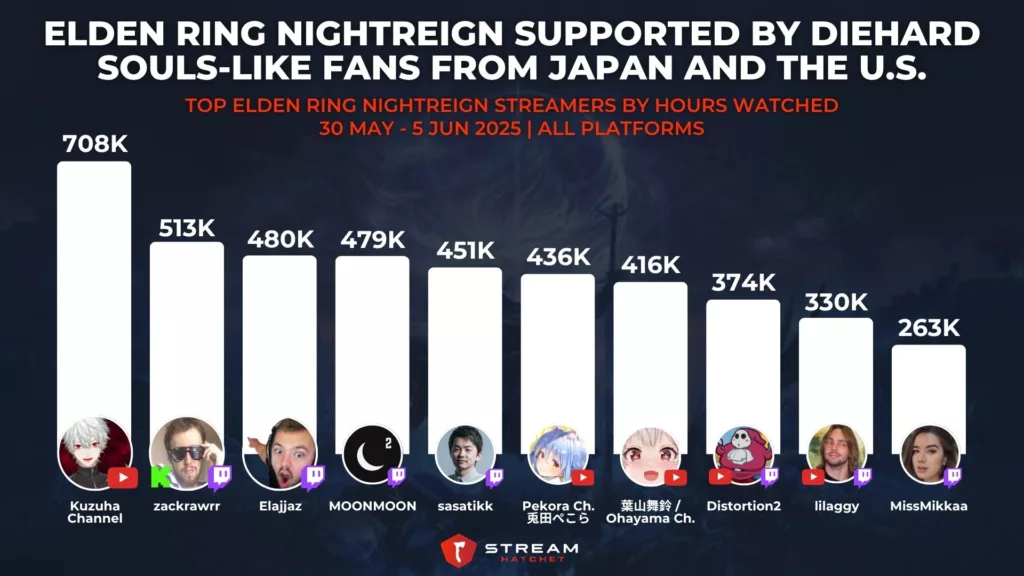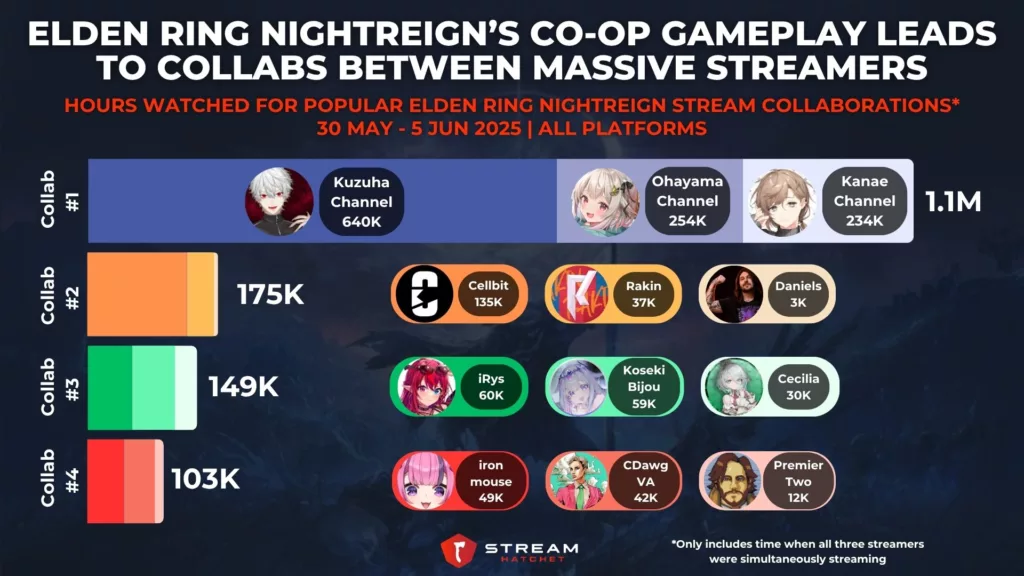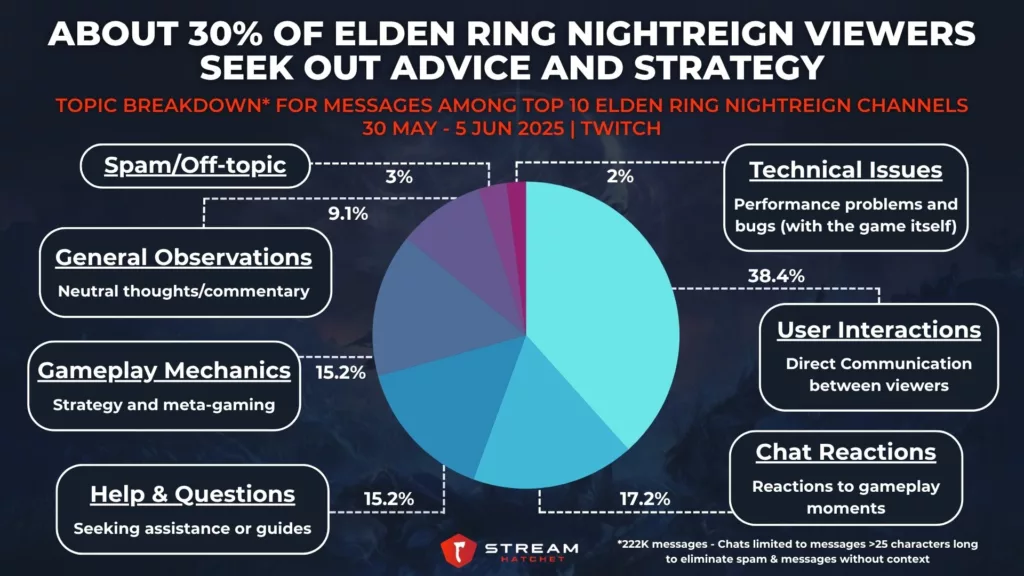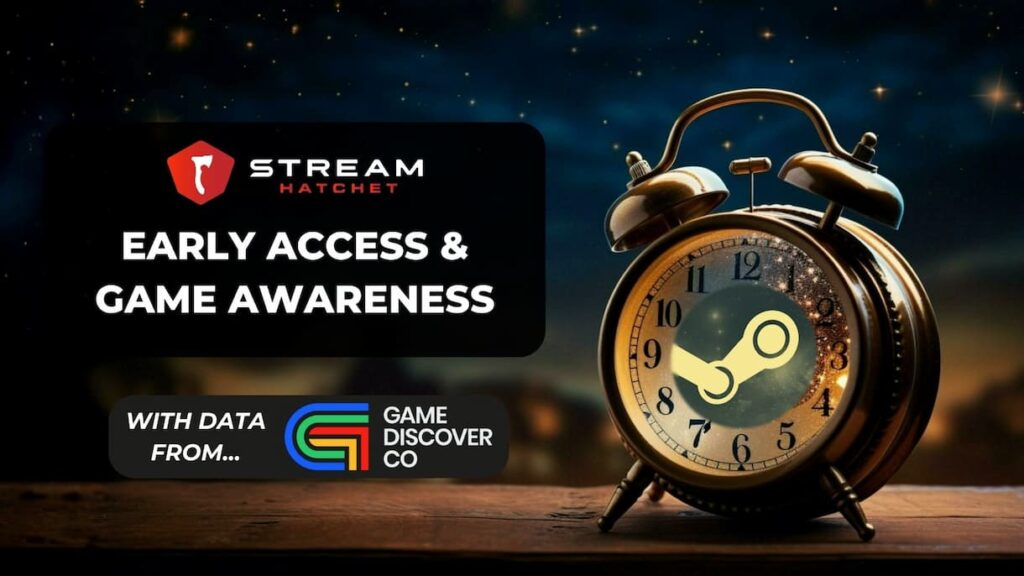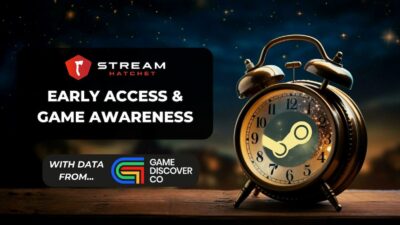Elden Ring Nightreign seemed set to be a hit on live-streaming platforms. The original Elden Ring was one of the most hyped game launches of all time, and the Souls-like subgenre continues to exceed expectations despite becoming increasingly crowded… it seemed that this new spin-off title’s success was a foregone conclusion.
And yet FromSoftware’s attempt to create a co-op version of its Souls-like formula didn’t seem to pan out. People played of course, but the game’s reception was divided as some fans were turned off by this arcade-y approach to the world of Elden Ring (which borrowed mechanics from Battle Royales like Fortnite). Additionally, the game virtually requires multiplayer, with players accepting that the game is just too hard to play solo. With this in mind, streaming became an essential way of showcasing how co-op Elden Ring gameplay looks and encouraging players to jump into multiplayer gameplay. Let’s look at how FromSoftware attempted to smooth this transition from RPG to co-op gameplay using live streaming.
Elden Ring Nightreign Struggles to Live Up to Its Namesake
First of all, let’s get a measure of how Elden Ring Nightreign performed. In its first week on live streaming, Elden Ring Nightreign brought in 28.8M hours watched: An impressive number, but still only ⅓ of the viewership that Elden Ring brought in over the same period. There’s a strong sense that this viewership was driven by name brand awareness more than that game itself. More worryingly, the spin-off failed to even come close to the hype for last year’s Elden Ring: Shadow of the Erdtree DLC which pulled in 40M more hours watched (note that we’ve excluded Steam viewership from all these totals, as the Steam Store page tends to inflate watch times).
It may be that the main determiner of viewership here is whether the game offers new content. Elden Ring Nightreign attempted to create a new game from (almost) entirely reused assets: For live-streaming viewers in particular, there’s just not that much more to see after you get the gist of the game. Being PvE makes this recycled content even more glaring, with a lack of diversity in gameplay one might get from PvP interactions and subsequent evolving metas. A single run in Elden Ring Nightreign lasts around 40 minutes and only then (if you survive) do you get to see the game’s new content. That’s 40 minutes of waiting. Every. Single. Run. All this adds up to a fairly repetitive viewing experience – not great entertainment.
In the past, we’ve seen how new releases in a franchise can momentarily boost viewership for previous entries (like with Resident Evil). This effect on Elden Ring viewership was more muted, however, with only a small spike in viewership of around 80K daily hours watched when Elden Ring Nightreign launched. We can glean a lot from this though: The fact there wasn’t an influx of new viewership for Elden Ring leading up to Elden Ring Nightreign’s release suggests that it may have been released too soon after Shadow of the Erdtree. If more time had been left, fans might have been craving a new experience and grabbed onto this title. This would also give some downtime for players/viewers burned out on the slew of challenge runs dominating live streaming coverage for the game.
Streaming Support for Elden Ring Nightreign Keeps it Alive
Putting aside Elden Ring Nightreign’s prestigious lineage, there’s another reason it should have performed well on live streaming: It’s a co-op game. Co-op games perform fantastically on live streaming as they create drama between the streamers whilst also encouraging communication between them (unlike, necessarily, a PvP game). This makes them a great source for collaborations, which pulls in streamers and, consequently, their viewers – but more on that in a moment.
The top streamers supporting Elden Ring Nightreign upon its release were diehard Souls-like and FromSoftware fans from Japan and the U.S., with Kuzuha leading the way with 708K hours watched in the game’s first week. There were plenty of other VTubers playing as well, including Usada Pekora and Hayama Marin with 436K and 416K hours watched, respectively. The other top streamers were made up of the usual suspects that support big game launches, such as zackrawrr (513K), elajjaz (480K), and hardcore Souls-like streamer Distortion2 (374K).
Kuzuha wasn’t just the most popular streamer: He led one of the most popular streamer collaborations in Elden Ring Nightreign’s opening week. Between Kuzuha, Kanae, and Hayama Marin, the trio brought in 1.1M hours watched through their collaboration. That only includes the time when all three streamers were playing Elden Ring Nightreign simultaneously. Other collaborations were lower, however, hitting around the ~150K hours watched mark from shorter collaborative streams. If there are more sponsored collab streams in the future between streamers with disparate audiences, this could provide a strong boost to the game’s viewership.
FromSoftware put in the effort to ensure players rallied behind Elden Ring Nightreign’s co-op gameplay on live streaming. Principally, Elden Ring Nightreign partnered with Twitch itself to create a number of custom events for dedicated fans. For example, special badges were awarded for specific actions: Streamers that used Twitch’s Stream Together feature to play the game received one badge, while fans who clipped and shared Elden Ring Nightreign content earned a different badge. This second badge was a great incentive to drive earned media – a crucial component for influencer marketing campaigns. FromSoftware then bolstered these efforts with a number of other streaming-specific goodies, like custom Twitch overlays based on the game’s 8 classes and a Global Death Counter tracking in-game deaths among the entire community.
Viewers Want to Know More About Elden Ring Nightreign’s Gameplay
Among viewers who did tune into Elden Ring Nightreign streams, there were a few key topics under discussion. The most frequent type of interaction was, unsurprisingly, interactions between users (38.4%), which is the main draw for jumping on Twitch chat in the first place. But a massive 30.4% of messages were interested in Elden Ring Nightreign’s mechanics and how to play the game. This is a great result: Players engaging with new gameplay elements and seeking out advice on live streaming is a great way to bond the community together, typically seen in games with complex mechanics like Monster Hunter Wilds and Diablo IV.
There is an obvious caveat here, however: A significant proportion of these messages may center around frustration or criticism rather than curiosity. This is still important, however: If FromSoftware can access this live-streaming sentiment then they can discover problem areas in gameplay and either improve them in subsequent updates or take these lessons into future game launches. For a studio like FromSoftware that has a reputation for quality, this feedback loop is key to maintaining their fans’ trust.
_
FromSoftware’s angle of partnering with Twitch to promote collaborations and earned media was a smart move, trying to leverage the popularity of Elden Ring among live-streaming audiences to activate their core fan base and create new hype for Elden Ring Nightreign. However, the campaign seemed to go awry without direct partnership with key influencers, with FromSoftware instead relying on organic pickup. And for organic traction, you need a solid game – instead, players were left unimpressed by the game’s reused assets and the absence of Elden Ring’s trademark atmosphere.
But this is a new venture for FromSoftware: With time, challenge streams, and teams of coordinated players pushing the game’s mechanics to their limits, there may be gas left in the tank for Elden Ring Nightreign. Unlike the original title, this spin-off is better suited to ongoing support by FromSoftware: If they release major updates or run events in the future, a second wave of influencer marketing with diehard supporters could build this format into something that could even rival existing live service games.
To keep up to date with the impact of the latest big game launches on live streaming, follow Stream Hatchet:
